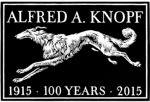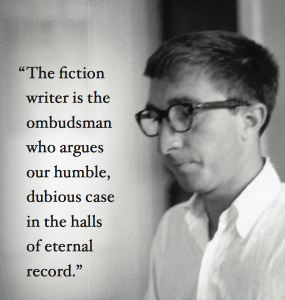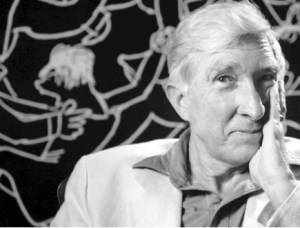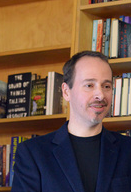 Writer-musician Art Edwards has published two online essays on Updike and David Foster Wallace:
Writer-musician Art Edwards has published two online essays on Updike and David Foster Wallace:
“David Foster Wallace was Wrong: Why John Updike Mattered and Always Will” appeared in the March 2013 issue of Word Riot. In it, the admitted Wallace fan says it annoyed him that “Wallace got so much wrong in his review of John Updike’s Toward the End of Time. . . . Wallace dismantles Time, and Updike’s character choices in many of his novels, and the ‘Great American Narcissists’ (Updike, Mailer, Roth) for their ‘radical self-absorption’ and ‘uncritical celebration of this self-absorption both in themselves and in their characters.'”
“I couldn’t agree more with Wallace’s assessment of Time,” Edwards writes. “I also found it to be ‘a novel so clunky and self-indulgent that it’s hard to believe the author let it be published in such shape.'” Edwards identifies himself as “the rare Updike fan of [his] generation, a group Wallace describes as under forty at the time of his review’s original publication (1997)” and says he’s read “twenty or so of Updike’s novels, many more than once,” and “loosely modeled” his first novel after Rabbit, Run.
He writes that Wallace’s “charges of Updike’s radical self-absorption are distracting from what’s wonderful about Updike’s work, and I suspect these charges will scare many of my and younger generations away from the writer. Wallace’s central charge is that Updike writes about one protagonist over and over again—all ‘clearly stand-ins for Updike himself’—and that the protagonist is ‘always incorrigibly narcissistic, philandering, self-contemptuous, self-pitying . . . and deeply alone, alone the way only an emotional solipsist can be alone.’
“To which I say, ‘Yeah, so?’ The literary canon is filled with writers who write about narcissists (Hemingway), and one character type over and over again (Austen), and characters who are self-pitying (Proust), and self-contemptuous (Beckett) and philandering (Miller). . . . What Wallace eels to mean is Updike’s characters are all of these things, and that makes them unsympathetic to him. And that’s where Wallace and I differ. I find all of Updike’s self-involved characters enormously sympathetic, often for the reasons Wallace mentions.”
“The Pot Calling the Kettle Narcissistic: The Lives and Works of John Updike and David Foster Wallace” appears in the Winter 2014 issue (dated January 15, 2015) of Cigale Literary and offers a further consideration of the two writers. Edwards says he continued his “education in Wallace” by working his way through “D.T. Max’s biography of the author Every Love Story is a Ghost Story,” and also rereading Updike’s Self-Consciousness.
“Updike was so under the spell of his country,” Edwards concludes, that “he had a notorious blind spot for a time when its motivations may have been less than savory. I’m referring to his famous marginal support of U.S. involvement in the war in Vietnam. . . . America was, for Updike, a safe haven, and to defend her, even in her atrocious moments—especially!—was his only way of paying back in kind,” he posits.
Of Wallace, he writes, “Wallace was as committed as he could be to combatting his nation’s addition to addictions. Around the time of Infinite Jest’s publication, he championed a more moral fiction, one that didn’t rely solely on dramatizing ‘how dark and stupid everything is.’ He continues, ‘In dark times, the definition of good art would seem to be art that locates and applies CPR to those elements of what’s human and magical that still live and grow despite time’s darkness.’
“These differences between Updike’s and Wallace’s points of view could easily be written off as differences in emotional makeup—and they were distinct in this regard—but others could have been more circumstantial. While neither writer went into the military (Updike was 4Fed for psoriasis, to his dismay; it’s hard to imagine Wallace ever seriously entertaining the idea of the military, their respective eras’ prevailing attitudes toward war were quite different. . . .”
Click on the essay titles to read the articles in full.
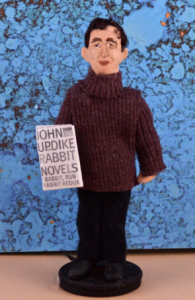 Like Updike’s main witch in The Witches of Eastwick, artist Debbie Ritter makes small figurines—not women, like Alex’s “bubbies,” but authors and characters from literature.
Like Updike’s main witch in The Witches of Eastwick, artist Debbie Ritter makes small figurines—not women, like Alex’s “bubbies,” but authors and characters from literature.
